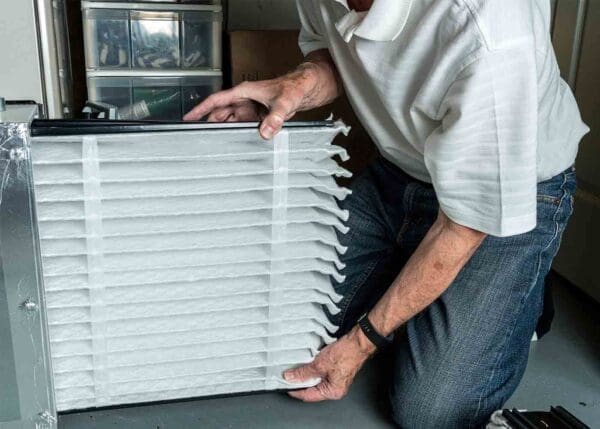01. Asbestos Risk for HVAC Workers
How Are HVAC Workers Exposed to Asbestos?
HVAC workers may have experienced asbestos exposure while working in homes and buildings. Before the 1980s, many structures were built with asbestos-containing materials. Some HVAC systems were also made with asbestos parts.
For example, asbestos was commonly found in gaskets and insulation. Asbestos was a valuable additive because it improved heat resistance and durability.
Workers may come in contact with asbestos while maintaining and repairing HVAC systems. Asbestos exposure may also occur when workers are removing or replacing old parts.
HVAC workers may grind, saw, cut or damage asbestos-containing materials.
Broken asbestos materials may release asbestos fibers into the air. Airborne asbestos fibers create a serious health hazard. Workers who inhale or ingest asbestos risk developing mesothelioma, lung cancer or asbestosis.
What Asbestos Products Put HVAC Workers at Risk?
Several products used in the HVAC industry were once made with asbestos. HVAC workers may have been exposed to asbestos from:
- Air duct systems
- Asbestos blankets
- Boilers
- Ceiling tiles
- Cooling towers
- Floor tiles
- Furnace ducts
- Gaskets
- HVAC vibration dampeners
- Insulation
- Steam pipes
Companies can no longer manufacture asbestos products. However, some HVAC mechanics may still be at risk of asbestos exposure in older buildings and homes. Old products may still be present in some structures.
Common Places HVAC Workers May Be Exposed to Asbestos
HVAC professionals work in many types of residential homes and commercial buildings. Until the 1980s, HVAC systems in buildings often contained asbestos products.
Locations where HVAC workers have been exposed include:
In these buildings, HVAC technicians often work in confined, poorly ventilated areas. Low ventilation may cause exposure to highly concentrated asbestos dust.
For example, friable asbestos in a boiler room or an air duct system puts workers at high risk of exposure.
HVAC Workers and At-Risk Trades
A variety of HVAC workers may have risked asbestos exposure. At-risk trades in the HVAC industry include:
- Boilermakers
- Electricians
- Fabricators and assemblers
- General repair workers
- Heat and frost insulators
- HVAC contractors
- Machinists
- Pipefitters
- Refrigeration mechanics
- Stationary engineers
- Steamfitters
Today, individuals in many HVAC occupations remain at risk of exposure to asbestos due to aging buildings and products.
Family members of HVAC workers also risk secondhand asbestos exposure. After working in confined areas, asbestos fibers may settle on workers’ clothing, skin and/or hair.
As a result, HVAC workers bring home asbestos fibers at the end of the day. Loved ones who launder asbestos-contaminated clothes may experience secondhand exposure.
02. Mesothelioma Risk for HVAC Workers
Mesothelioma Risk for HVAC Workers
HVAC workers who have experienced asbestos exposure are at risk of developing mesothelioma.
In a 2017 study, researchers analyzed asbestos deaths in the United States from 1970 to 2014. Researchers found insulation workers and boilermakers died from asbestos illnesses at higher rates than other occupations.
The study also noted HVAC workers were 4.4 times more likely to pass away from an asbestos-related illness than the general population.
Mesothelioma has a latency period of up to 50 years. HVAC professionals who worked with asbestos products in years past may still develop the disease today.
Individuals who have known occupational asbestos exposure should stay up to date on cancer screenings. Early mesothelioma diagnosis and treatment are the best ways to extend life expectancy.
03. Compensation for HVAC Workers
Compensation for Victims of Occupational Asbestos Exposure
HVAC workers with mesothelioma from occupational asbestos exposure may seek compensation. Individuals can file a mesothelioma lawsuit or workers’ compensation claim against asbestos companies.
After facing a large number of lawsuits, some companies set up asbestos trust funds. By filing an asbestos trust fund claim, eligible individuals may receive compensation.
Workers may contact a law firm to determine eligibility for a lawsuit or mesothelioma claim. Experienced mesothelioma lawyers can help build a case and hold negligent companies responsible.
04. Asbestos Safety
Asbestos Safety for HVAC Workers
The Occupational Safety and Health Administration (OSHA) requires employers to provide safeguards for Class I HVAC workers. Safeguards mandated by OSHA include:
- Sealing HVAC systems within isolated areas using two layers of six mil plastic sheeting to prevent contamination
- Shutting off HVAC systems during asbestos abatement projects or when asbestos construction materials are likely to be disturbed
These rules help HVAC workers decrease their risk of airborne asbestos exposure.







